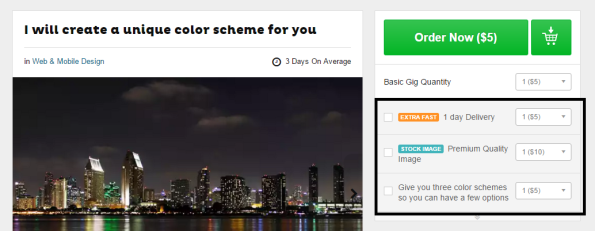Upselling and cross-selling are two techniques you’ve probably came across numerous times without even being aware. In fact, a lot of major companies use them, such as McDonald’s, KFC or Fiverr, for example.
What is Upselling?
Upselling is a sales technique where the seller convinces you to buy a more expensive item than the one you’ve initially picked or add-ons to it. For example, if you go to McDonald’s and order a menu without pointing out the size, you will usually be asked: “Do you want it large?”. If you’re easily persuaded you may say “yes”, even if you were looking to buy the medium-sized one.
Fiverr also uses it by suggesting you to buy extra gigs from its sellers.
Here’s Wikipedia’s definition of upselling.
How Can You Use Upselling in Freelancing?
Every service that you offer can have a premium side to it or some small additional service you can sell as an extra. I will give copywriting as an example, as this is the field I’m most experienced in.
a) If the customer asks for a 500-word long article, you can suggest than a 700-word article would be more appropriate, as they rank better.
b) You can ask if they want images added and charge for them.
c) You can sell SEO optimization of the article as a separate service.
These are just a few example but, if you sell at least one of these services on each contract, you may see a good increase in revenue at the end of the month. We had customers that offered to pay for images or SEO optimization without us even asking and you may be in the same situation with the extra services you are planning to offer. Thus, upselling may not be that hard to do.
What is Cross-Selling?
Although not much different from upselling, cross-selling refers to selling a different product or service to an existing customer, apart from the one he is already looking to buy. For example, if you would be selling SEO services, the customer may also need copywriting work done, as they usually go together. If you don’t offer content services yourself you can team up with other freelancers and either take a commission for every project you provide them with or just have a customer exchange agreement. He could cross-sell your services as well.
You can find a more complex definition of cross-selling here.
In my previous article I was telling you about how having Andreea as a freelancer helped me gain a lot of new projects. I was a freelance SEO while she was a freelance copywriter. Each time she got hired for a new project she would also ask customers if they’re looking for SEO services as well while I was doing the same for her. This strategy really doubled our chances of getting new projects and having continuous work. For example, during September of October last year, I was hired by a Canadian company to optimize their website. As they were just starting they also needed copywriting so I managed to connect Andreea to the project as well. We both had continuous work for the next 3-4 months this way.
The first examples of cross-selling that come to my mind are seminars. I’m sure you’ve attended at least one in your life. While you already pay a fee to be there, the person hosting the seminar will also try and sell you books or other materials as audio CD’s or a place in their upcoming online training sessions.
Both upselling and cross-selling are great ways to increase your monthly revenue without putting a lot of extra effort in. You just have to make a list with the sub-services or products you could sell you customers and advertise these to them. You will be surprised to realize that most clients will be open to your suggestions.

